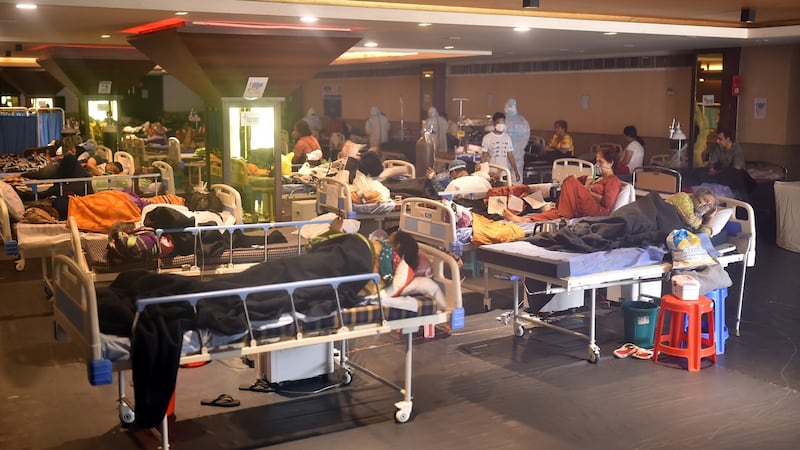As a second coronavirus wave ravages India, overwhelming its already inadequate medical and public health facilities, the mood among the majority of the country's 1.3 billion people is one of alarm, panic, hopelessness and anger.
Miracles and prayer are what tens of millions are now depending on, as India’s coronavirus case tally exceeded 300,000 on Tuesday for the sixth consecutive day.
The daily death toll, mostly of people aged under 45, passed 2,900, but analysts said this was an under-representation, as the numbers being cremated or buried countrywide far exceeded this figure.
Medical experts have also questioned the official number of Covid-19 cases, which they claimed was significantly higher, as overworked and understaffed laboratories, unable to cope with the onslaught of testing, either took a week or more to process results or simply abandoned them.
Mathematical projections indicate that India’s daily tally of new infections from May 4th onwards could hit 440,000, peaking at 3.3 million-3.5 million cases by the end of the month.
This alarming prognosis by two prestigious Indian institutes of technology, in Kanpur in north India and Hyderabad in the south, suggest the period May 14th-18th could end up as the peak timing for active infections, as the newer and more virulent virus mutants fuel a resurgence.

Such disquieting statistics, however, do not embody the abject human suffering on the ground. Ambulances for virus-infected patients are becoming scarcer, and the handful that are available are charging up to 25,000 rupees (€275), or 20 times the normal amount, to ferry the sick short distances to hospitals or nursing homes, where the likelihood of their admission is non-existent.
All government and private medical facilities, without exception, in major cities and small towns across India – the majority of them poorly equipped at the best of times – are overloaded with coronavirus cases and are simply turning away new patients.
Consequently, interminable lines of patients with Covid are scattered on the ground outside these barricaded facilities gasping for breath, as their relatives or loved ones futilely beg security staff to let them in.
Sharing oxygen
Television news channels relay footage of patients sharing oxygen gas cylinders on makeshift gurneys in their cars in hospital car parks or on nearby pavements, hoping for medical assistance that is rarely forthcoming.
The situation inside hospitals is equally dire. Infected patients languish two or three to a bed, while those less fortunate lie comatose in the corridors with overextended medical staff stepping over them.
Government hospitals, labouring under a 75 per cent shortage of medical specialists even before the pandemic, are running short of nurses and paramedics, as well as beds in intensive care units and ventilators.
One doctor at a leading New Delhi hospital said medical staff did not have time to mourn any patient's loss. "We simply wheel the dead body off quickly, change the sheets and get another patient on the same bed, hoping he or she survives," he said.
All hospitals across India were dealing with a shortage of oxygen on Tuesday for the sixth day in a row, with reserves in many instances of less than an hour.
These deficiencies have resulted in scores of patients in hospitals in Jaipur in western Rajasthan, Amritsar in northern Punjab state and Rewari in adjoining Haryana state, and in several other places, dying of asphyxiation over the past three days.
In desperation many who could afford it bought 50-litre oxygen cylinders, normally costing €50, for €900 each in a thriving black market. Palliative medicines were being acquired in similar circumstances, with the anti-inflammatory Tocilizumab injection retailing for an average €2,500, more than five times its usual price.
Mass cremations
There was no relief even for the dead, with bodies in worst-hit cities such as Delhi and Bangalore being mass cremated in makeshift facilities in parks and on roads. Others were being randomly consigned to hastily dug graves in public grounds, as designated cemeteries were filled to capacity.
Prime minister Narendra Modi’s Hindu nationalist Bhartiya Janata Party has come in for widespread criticism for being unprepared for the second outbreak, despite adequate advance warning.
Modi and Amit Shah, his interior minister, have been pilloried on social media for holding at least 44 massive election rallies and roadshows from March 1st onwards in the politically critical eastern Bengal state, which is voting to elect an assembly.
Modi is also being censured for not stopping millions of Hindu devotees from bathing in the Ganges river, which they consider sacred, during the ongoing Kumbh, or Pitcher Festival, which takes place every 12 years. The local BJP chief minister Tirath Singh Rawat had declared that "Mother Ganges" would protect the devotees from the virus, a few days before he tested positive for Covid-19.
Several cities, including Delhi, Mumbai and Bangalore, have enforced curfews for the next fortnight and possibly beyond in a feeble effort at breaking the chain, but few have much hope.
"In the face of this massive calamity, India's political leadership has been leading from behind," said Manoj Joshi of the Delhi-based Observer Research Foundation. Policy did not go wrong, he added, there simply was no policy.


















